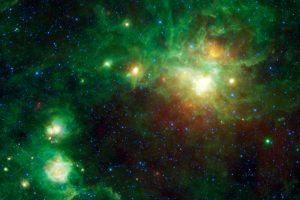Splendide regioni di formazione stellare
 Questa immagine del telescopio Wide-field Infrared Survey Explorer (WISE) mette in evidenza diverse splendide regioni di formazione stellare: se ne possono individuare almeno cinque in questa immagine. Si tratta di regioni HII, nubi di gas e polveri riscaldate da vicine, calde stelle di recente formazione.
Questa immagine del telescopio Wide-field Infrared Survey Explorer (WISE) mette in evidenza diverse splendide regioni di formazione stellare: se ne possono individuare almeno cinque in questa immagine. Si tratta di regioni HII, nubi di gas e polveri riscaldate da vicine, calde stelle di recente formazione.
La nube più brillante, in alto a destra, è conosciuta come Gum 22. Prende il nome da Colin Gum, un astronomo australiano che ha esaminato il cielo dell’emisfero australe nei primi anni ’50 alla ricerca di regioni di formazione stellare e ha catalogato 85 regioni simili a queste.
Andando in senso antio
rario a partire da Gum 22, le altre nebulose nell’immagine sono Gum 23 (parte della stessa nube di Gum 22), IRAS 09.002-4732 (nube arancio vicino al centro), Bran 226 (la nube più in alto fra le due visibili in basso a sinistra), e infine Gum 25, in basso a sinistra. Sono presenti inoltre diverse regioni più piccole e/o più lontane, sparse in tutta l’immagine e ancora da catalogare. Si ritiene che la maggior parte delle regioni siano parte dello Sperone di Orione, all’interno della Via Lattea. Le loro distanze variano tra 4.000 e 10.000 anni luce dalla Terra.
Si noti la stella verdastra molto luminosa in basso a destra: si tratta di una stella un pò speciale. Conosciuta come IRAS 08535-4724, è una stella al carbonio. Stelle come questa sono simili alle giganti rosse, sono molto più grandi del Sole e si trovano nelle ultime fasi della loro vita, ma sono caratterizzate da quantità insolitamente elevate di carbonio nella loro atmosfera.
I colori utilizzati in questa immagine rappresentano specifiche lunghezze d’onda infrarosse. Blu e ciano rappresentano la luce emessa a 3,4 e 4,6 micron, prevalentemente luce stellare. Verde e rosso mostrano la luce a 12 e 22 micron, rispettivamente, per lo più emessa dalla polvere.
[ Barbara Bubbi ]
http://wise.ssl.berkeley.edu/gallery_gum22.html
Credit: NASA/JPL-Caltech/WISE Team
Lascia un commento